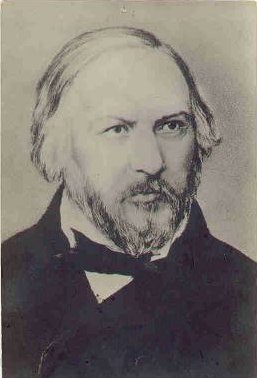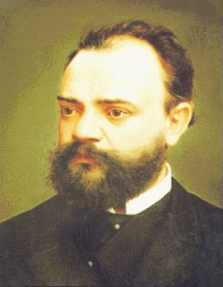Mikhail Glinka (1804-1857)
Overture- Russlan and Lyudmila

- The basic story of the opera tells how Lyudmila, daughter of the Grand Prince of Kiev, is abducted by the wicked dwarf; Chernomer, from the feast held to celebrate her betrothal to the warrior Russlan. Her father promises her hand to the man who rescues her and consequently Russlan sets out with two rivals to rescue her. On his travels Russlan meets a good magician named Finn who warns him to be wary of distractions i.e. a temptress named Naina. Russlan finds a magic sword which he takes to Chernomer's castle where a battle takes place. Russlan wins only to find Ludmilla in a charmed sleep. Taking Lyudmilia back to Kiev he awakens her with a magic ring, provided thoughtfully by Finn, whereupon there are great scenes of rejoicing.
- The overture's function is to depict the conflict between Russian and Chernomer. The autographed score and the orchestral parts of the opera were destroyed in a theatre fire in St. Petersburg in 1859. Fortunately, a manuscript copy existed and the full work was published from this in 1878 under the direction of Balakirev, Lyadov and Rimsky-Korsakov.
Piano Concerto No 3 Op37
1 Allegro con Brio
2 Largo
3 Rondo (Allegro)
-
Beethoven was thirty when he completed what is now known as his Third Piano Concerto. It was, in fact, the fourth piano concerto he had composed. At the age of fourteen, he had written a concerto in the key of E-flat, a work that he did not publish. Then, in 1793 and ‘95, he wrote two more concerti that did appear in print and all three of these concerti precede the “third” concerto, his opus 37. Of all these works, this was the first to use a minor key and the first to reject the dominant Mozart like style of piano concerto, in which graceful phrases flow back and forth on the keyboard, echoing with the orchestra. Beethoven, who in earlier years had played such works with great success, had gradually grown to despise them, snarling about pianists who, in his words, “only run up and down the keyboard with long-practiced passagework, putsch, putsch, putsch!” Here, by contrast, Beethoven produced a more varied and dynamic work rich in the turbulent emotions for which he was becoming known. The Third Concerto spent a few years lying more-or-less complete on the shelf before a belated premiere on April 5, 1803, at the Theatre an der Wien. As was typical of this composer who disliked sharing the spotlight, the entire program was comprised of Beethoven works. In addition to the new concerto, audiences would also hear the First and Second Symphonies and the oratorio “Christ on the Mount of Olives.”
-
Of all four compositions, only the First Symphony had been performed before, so it was new music requiring much preparation by the performers. Due to its complexity, the oratorio co-opted most of the rehearsal time, leaving for the concerto only enough time for one quick run-through on the morning of the concert. Preparation was so rushed that the composer had not yet managed to write out the entire solo piano part, a fact that did not concern Beethoven at all. Since he would be the soloist himself, he planned to save time by playing mostly from memory. However, his page-turner found the situation unsettling. “I saw almost nothing but empty leaves,” the poor man later recalled, “at most on one page or the other a few Egyptian hieroglyphs wholly unintelligible to me scribbled down to serve as clues for him... He gave me a secret glance whenever he was at the end of one of the invisible passages, and my scarcely concealed anxiety not to miss the decisive moment amused him greatly. He laughed heartily at the jovial supper we ate afterward.” Beethoven did not write out the entire solo part until a year later, when his student Ferdinand Ries was due to play the work and was, apparently, averse to playing invisible notes. The piano on which Beethoven himself played, that for which he composed this concerto, was quite different from the modem piano on which it is generally performed today. Fortepianos of the eighteenth century had a softer, mellower sound, far less brilliant than that to which audiences are now accustomed, and the instruments themselves were far less forgiving of heavy-handed playing. Indeed, the light and graceful style of piano performance that Beethoven so despised had developed specifically to accommodate the limitations of the instrument. A firmer touch could lead to broken strings, as those who invited Beethoven to play their own fortepianos found to their dismay. Not until 1818,' when he received his beloved and hearty Broadwood grand piano, would Beethoven have a piano equal to his imagination. At the time of the Third Concerto, he was making do with a gentler instrument, one that he often played with almost continuous pedal so as to produce at least a measure more resonance. No one would have been more delighted than he to hear the richness with which the work can be rendered today.
Antonin Dvorak (1841-1904)
SYMPHONY NO.9 IN E MINOR 0P95
1. Adagio- Allegro molto
2. Largo
3. Molto Vivace
4. Allegro con brio e feroce

-
Just before the turn of the century, Dvorak spent two years in America, teaching at a Czech colony at Spiliville in Iowa. He was one of the big names both as a composer and teacher, and as America was beginning to feel herself somewhat behind culturally, anything or anyone that could be got in from Europe was pure gold especially in music There was no such thing as an ‘American' school of composers An American composer would study in Europe with Liszt or Brahms then return home with a portfolio of fine academic compositions sounding like Liszt or Brahms, and the more the better. Dvorak arrived with a spirit of nationalism that was sweeping the European nations. You could hear a piece of European music and know at once what nationality it represented: Bohemian music by Smetana and Dvorak, Norwegian dances by Grieg and Russian operas by Borodin, Glinka and Mussorgsky. Dvorak was received as an evangelist of nationalism and was appalled by the imitative procedures of American composers He could not understand why they were not producing equally nationalistic music in their own terms, especially in a country abounding in folk traditions and folk material of the most varied and exotic kinds: Indian chants and dances, Negro spirituals, ballads, laments and work songs. He told them they must use their heritage, not realising, of course, that the American composers of the time had no heritage, were not Indians or Negroes. Americans were cultural imports from Europe with totally different backgrounds and none of them American. Real native American art was to be found in the reservations, not in the cities and certainly not in the world of art. Dvorak was suggesting that they write self conscious American music based on folklore that was not really their own: they had never gone out into the fields, or prayed for rain beating drums, or sung laments on the levee. But they were so impressed by this seemingly simple recipe that they responded with a flood of Negro operas and suites which still, to this day, gather dust on library shelves. Composers like MacDowell, Gilbert Cadman and Herbert were in the vanguard, inspired by a great, misnamed example by Dvorak himself, a model of the new American music, a “New World” Symphony. What Dvorak actually wrote was a beautiful finely wrought, deeply felt Old World Symphony. There are tunes here and there that sound Indian or Negro or both, although Dvorak denied any authentic origin, but the resultant music is Bohemian, or central European, or Brahmsian, or even Dvorákian, but not by any stretch of the imagination American. The real American music came with a post First World War American spirit namely, jazz. There are many moments in Dvorak's masterpiece which have been described as “New world”. The opening slow introduction has the qualities of an introspective European meditation. Later on this introduction shows striking resemblances to Brahms' introduction to his first symphony's Finale; which is not at all surprising as the two men were so close. With syncopations, diminished chords and timpani, Dvorak seems more involved with Brahms than America here. The main theme, with its syncopations, has been described as “American”, with its similar feel and the next few bars are pure Czech. A secondary subject, cited as Indian is in the folk scale of the Aeolean mode, which is not only Indian but early English, Gregorian, Hindu, African and ancient Greek. This particular section could be a French medieval basse-dance. There is a tune which has been described as a relative of “swing low sweet chariot”. Dvorak denied this and pointed to Czech folk use of the pentatonic (5 note) scale, also occurring in other symphonies of his, and Smetana.
-
The slow movement starts with a tune known to millions as Goin' Home”, a Negro spiritual. Actually this is not a spiritual at all, but a specially composed song based on Dvorak's tune and written three years later! There is nothing really Negro at all about this tune, except its use of the pentatonic tune again and the atmosphere of the movement has more to do with Dvorak's opera Rusalka, about a Czech water nymph than Sitting Bull or Uncle Tom. Later in the movement we have German hunting horns, a beautiful brooding theme worthy of Smetana and a sprightly French style peasant jig, so nothing American here unless you count “Goin' Home” which isn't.
-
The third movement is a Czech dance, a Furiant, with an Austrian trio, reminiscent of Schubert and beer halls, mixed with Dvorak's genius.
-
The finale opens in very ferocious Slavic mood. Its first bars echo the witch “Baba Yaga's hut on chicken legs” from Mussorgsky's Pictures, and there follows a Brahmsian union tune (though in that aeolean scale mentioned above) later harmonised in Central European colours. There then follows a dance-like section concluding with a reference to Wagner's Tanhauser, and an episode which starts like “Three Blind Mice” (which is a British round not American), but ends up totally Czech in spirit. There is perhaps a slight hint of Boogie Woogie in the bass line at the very end, but that of course is nonsense. Let us be grateful for a New World Symphony from the Old World traditions: after all Dvorak hated his American visits so much, each one of them grew shorter until eventually he stayed put at home. His “New World” compositions (the cello concerto, string quartet, sonatina for violin, suite in A) are really nostalgic postcards to the Old World “From the New World”.
